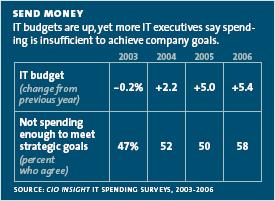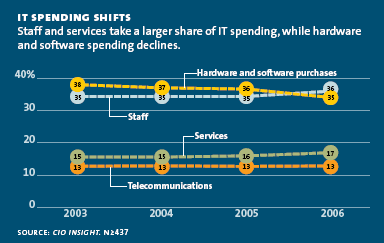This year’s CIO Insight spending survey finds that IT budgets in 2006-when weighted to reflect the fact that small and midsize companies far outnumber large companies, which have giant IT budgets-are up by 5.4 percent over 2005.
That’s a slightly larger increase than last year’s (unweighted) 5 percent budget increase. And since more than 70 percent of respondents believe they will find more funds for their projects during the year, most ought to feel reasonably confident about spending levels.
So why are even more CIOs concerned that IT budgets are insufficient to meet their company’s strategic goals this year than in 2005?
Here’s the problem: As the economy grows, and companies look to improve revenues and not just cut costs, the pressure is on for CIOs to pursue a wider variety of projects this year than in 2005. Nearly all of the 26 initiatives our survey tracked are showing up in more budgets in 2006.
Businesses remain cautious with their IT spending, says Ken Goldstein, an economist with the Conference Board, a business research organization based in New York City, because top managements are still spooked by all the money that was sunk into IT in the past. They believe that “businesses haven’t gotten full utilization out of what they spent, and they need to. They won’t necessarily cut back their spending, but what we will get is this cautious, conservative spending.” So CIOs must continue to do more with less.
Spending on many categories of hardware and systems is flat or down, while IT executives are trimming costs further by consolidating systems, replacing legacy systems, investing in virtual servers and storage, adopting open source and VoIP, and hiring outsourcers. At the same time, our study found that investments
supporting mobility and data integration are up. So, too, is spending on self-service technologies, content management and performance management. “People are taking on more, smaller projects,” says Ted Williams, president of the Information Management Forum, an association of IT executives based in Roswell, Ga.
CIOs also seem afraid of spending too little on business continuity and security, and of losing skilled workers. The largest increase in spending in 2006 is on training and development.
For the first time, we are providing both weighted and nonweighted numbers for the percentage change in spending year-to-year, and for the average IT budget.
The 5.4 percent figure is the weighted figure; the nonweighted change in spending is -0.9 percent. Why both numbers? Our concern is that the -0.9 percent figure fails to represent the actual change in spending. Our survey sample is divided fairly evenly between small, midsize and large companies.
But in reality, small U.S. companies far outnumber large ones. According to the most recent Statistics of U.S. Businesses program, there were 1,947 publicly and privately held companies over $1 billion, 13,156 between $100 million and $999 million, and 276,875 between $5 million and $99 million.
By weighting our total spending percentages, and the total dollar figures on which they are based, in proportion to the actual number of large, medium and small companies, we can offer statistics that better represent real world IT spending, and better analyze where that spending is headed.

